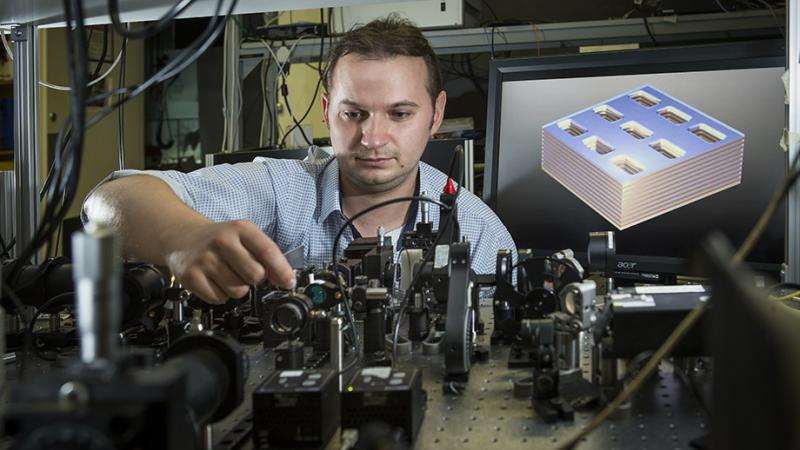Nanomaterial to drive new generation of solar cells

Physicists have discovered radical new properties in a nanomaterial which opens new possibilities for highly efficient thermophotovoltaic cells, which could one day harvest heat in the dark and turn it into electricity.
The research team from the Australian National University (ARC Centre of Excellence CUDOS) and the University of California Berkeley demonstrated a new artificial material, or metamaterial, that glows in an unusual way when heated.
The findings could drive a revolution in the development of cells which convert radiated heat into electricity, known as thermophotovoltaic cells.
"Thermophotovoltaic cells have the potential to be much more efficient than solar cells," said Dr Sergey Kruk from the ANU Research School of Physics and Engineering.
"Our metamaterial overcomes several obstacles and could help to unlock the potential of thermophotovoltaic cells."
Thermophotovoltaic cells have been predicted to be more than two times more efficient than conventional solar cells. They do not need direct sunlight to generate electricity, and instead can harvest heat from their surroundings in the form of infrared radiation.
They can also be combined with a burner to produce on-demand power or can recycle heat radiated by hot engines.
The research is published in Nature Communications.
The team's metamaterial, made of tiny nanoscopic structures of gold and magnesium fluoride, radiates heat in specific directions. The geometry of the metamaterial can also be tweaked to give off radiation in specific spectral range, in contrast to standard materials that emit their heat in all directions as a broad range of infrared wavelengths. This makes it ideal for use as an emitter paired with a thermophotovoltaic cell.
The project started when Dr Kruk predicted the new metamaterial would have these surprising properties. The ANU team then worked with scientists at the University of California Berkeley, who have unique expertise in manufacturing such materials.
"To fabricate this material the Berkeley team were operating at the cutting edge of technological possibilities," Dr Kruk said.
"The size of individual building block of the metamaterial is so small that we could fit more than twelve thousand of them on the cross-section of a human hair."
The key to the metamaterial's remarkable behaviour is its novel physical property, magnetic hyperbolic dispersion. Dispersion describes the interactions of light with materials and can be visualized as a three-dimensional surface representing how electromagnetic radiation propagates in different directions. For natural materials, such as glass or crystals the dispersion surfaces have simple forms, spherical or ellipsoidal.
The dispersion of the new metamaterial is drastically different and takes hyperbolic form. This arises from the material's remarkably strong interactions with the magnetic component of light.
The efficiency of thermovoltaic cells based on the metamaterial can be further improved if the emitter and the receiver have just a nanoscopic gap between them. In this configuration, radiative heat transfer between them can be more than ten times more efficient than between conventional materials.
More information: Sergey S. Kruk et al. Magnetic hyperbolic optical metamaterials, Nature Communications (2016). DOI: 10.1038/ncomms11329
Journal information: Nature Communications
Provided by Australian National University




















